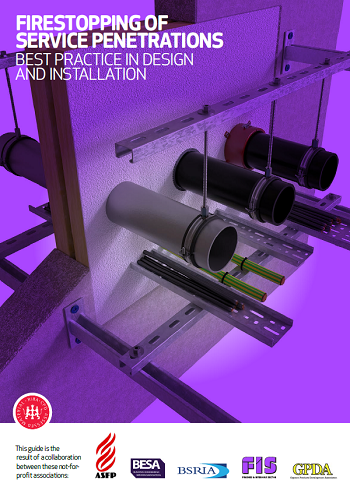Firestopping of service penetrations, Best practice in design and installation
Firestopping of service penetrations, Best practice in design and installation, was published by Finishes and Interiors Sector Limited (FIS) in 2020.
It was written with support and contributions from the following trade associations:
- FIS (Finishes and Interiors Sector).
- ASFP (Association for Specialist Fire Protection).
- GPDA (Gypsum Products Development Association).
- BESA (Building Engineering Services Association).
- BSRIA (Building Services Research and Information Association).
It is intended to assist in the design, specification and installation of building services penetrations to ensure fire compartmentation is maintained.
The aim of the guide is to encourage all stakeholders in construction to consider firestopping design earlier in the process in order to avoid problems at a later stage in construction. It is not an installation manual but guidance to a good practice approach. The guide is broken down to provide information on actions that should be carried out during each of the stages one to seven as defined in the RIBA Plan of Work.
Dame Judith Hackitt DBE FRENG FICHEME FCGI said: “This document is the result of a collaboration between a number of relevant trade bodies and organisations representing the wider construction and fire safety industries, and it is an example of the collaborative working and acceptance of professional responsibility throughout the supply chain that must become a feature of the industry’s culture from now on.”
The contents of the guide are:
- Foreword 1.
- Foreword 2.
- Introduction.
- Scope.
- Preparation and briefing.
- Concept design.
- Spatial coordination.
- Technical design.
- Manufacturing and construction.
- Handover.
- Use.
- Appendix a: Regulations, standards and industry guidance.
- Appendix b: Case study.
- References.
- Acknowledgements.
You can download the guide here.
It has also been turned into a short (free) online training course designed for building engineers, designers, installer, inspectors, or insurer who want to learn more about fire stopping.
During this course, you will learn about the design process for the selection of fire stopping of service penetrations, how to apply the nine golden rules, understand the importance of early engagement, as well as the terms and definitions used and the key questions to ask to ensure a compliant installation of fire stopping.
Knowledge check questions will be asked at the end of the course. Once you have completed the course, you can download a CPD certificate.
--FIS
[edit] Related articles on Designing Buildings
Featured articles and news
The UK's Modern Industrial Strategy: A 10 year plan
Previous consultation criticism, current key elements and general support with some persisting reservations.
Building Safety Regulator reforms
New roles, new staff and a new fast track service pave the way for a single construction regulator.
Architectural Technologist CPDs and Communications
CIAT CPD… and how you can do it!
Cooling centres and cool spaces
Managing extreme heat in cities by directing the public to places for heat stress relief and water sources.
Winter gardens: A brief history and warm variations
Extending the season with glass in different forms and terms.
Restoring Great Yarmouth's Winter Gardens
Transforming one of the least sustainable constructions imaginable.
Construction Skills Mission Board launch sector drive
Newly formed government and industry collaboration set strategy for recruiting an additional 100,000 construction workers a year.
New Architects Code comes into effect in September 2025
ARB Architects Code of Conduct and Practice available with ongoing consultation regarding guidance.
Welsh Skills Body (Medr) launches ambitious plan
The new skills body brings together funding and regulation of tertiary education and research for the devolved nation.
Paul Gandy FCIOB announced as next CIOB President
Former Tilbury Douglas CEO takes helm.
UK Infrastructure: A 10 Year Strategy. In brief with reactions
With the National Infrastructure and Service Transformation Authority (NISTA).
Ebenezer Howard: inventor of the garden city. Book review.
The Grenfell Tower fire, eight years on
A time to pause and reflect as Dubai tower block fire reported just before anniversary.
Airtightness Topic Guide BSRIA TG 27/2025
Explaining the basics of airtightness, what it is, why it's important, when it's required and how it's carried out.
Construction contract awards hit lowest point of 2025
Plummeting for second consecutive month, intensifying concerns for housing and infrastructure goals.
Understanding Mental Health in the Built Environment 2025
Examining the state of mental health in construction, shedding light on levels of stress, anxiety and depression.
























Comments
[edit] To make a comment about this article, click 'Add a comment' above. Separate your comments from any existing comments by inserting a horizontal line.